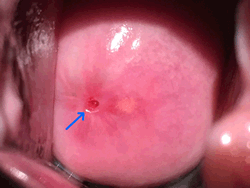A cyst is a sac-like structure filled with fluid. One of the many types of cysts that can be present in the human body is a Nabothian cyst.
Nabothian cysts are found on the uterine cervix, and are caused by the clogging of the cervical glands, also referred to as the Nabothian glands. These small cysts are usually found in two types of presentations. The first are serous filled cysts, and are seen as clear fluid-filled sacs on the surface of the cervix. In the accompanying image, these are depicted with a yellow circle.
The second type of Nabothian cysts are sacs filled with a yellowish, more dense and mucous-like fluid on the surface of the cervix. In the accompanying image, there is only one of these cysts and is depicted with a red circle.
The presence of Nabothian cysts is quite normal, they are not dangerous and are not cancerous. When present and when large, they may impede a gynecological exam and obscure the cervical os, the entrance to the uterus through the cervical canal. In the image the cervical os is indicated by a blue arrow. A gynecologist may need to open and drain these cysts prior to performing a Pap smear (named after Dr. George Papanicolau).
Nabothian cysts are named after Dr. Martin Naboth (1675 - 1721), a German physician and anatomist. His main publication in 1707 was “De Sterilitate Mulierum” (On Sterility in Women). In this book he refers to small pearl-like transparent structures found in the uterine cervix. Believing that he had discovered the way women store eggs, he called these “ovarium novum” (new ovaries). His discovery was accepted by many and these structures came to be known as “Ovula Nabothii“. Today we know this is not true, but his name remains attached eponymically to these structures.
My personal thanks toDr. Sanford Osher and his patient who volunteered and provided the image for this article. Dr. Miranda




